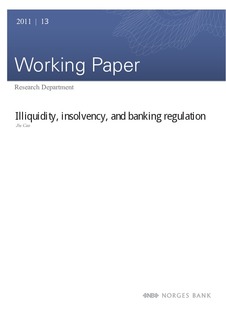| dc.contributor.author | Cao, Jin | |
| dc.date.accessioned | 2018-05-03T10:56:57Z | |
| dc.date.available | 2018-05-03T10:56:57Z | |
| dc.date.issued | 2011 | |
| dc.identifier.isbn | 978-82-7553-623-3 | |
| dc.identifier.issn | 1502-8143 | |
| dc.identifier.uri | http://hdl.handle.net/11250/2496948 | |
| dc.description.abstract | This paper provides a compact framework for banking regulation analysis in the presence of uncertainty between systemic liquidity and solvency shocks. It explains the asset price anomalies and bank lending freeze during the crisis. The paper shows how the coexistence of illiquidity and insolvency problems adds extra cost for banking regulation, making conventional regulatory policies fail, and why the unconventional central bank policy encourages moral hazard. A banking tax is proposed to cover the extra regulatory cost, and the regulatory cost can also be reduced by combining the advantages of several instruments. | nb_NO |
| dc.language.iso | eng | nb_NO |
| dc.publisher | Norges Bank | nb_NO |
| dc.relation.ispartofseries | Working Papers;13/2011 | |
| dc.rights | Attribution-NonCommercial-NoDerivatives 4.0 Internasjonal | * |
| dc.rights.uri | http://creativecommons.org/licenses/by-nc-nd/4.0/deed.no | * |
| dc.subject | JEL: E5 | nb_NO |
| dc.subject | JEL: G21 | nb_NO |
| dc.subject | JEL: G28 | nb_NO |
| dc.subject | liquidity risk | nb_NO |
| dc.subject | insolvency risk | nb_NO |
| dc.subject | liquidity regulation | nb_NO |
| dc.subject | equity requirement | nb_NO |
| dc.subject | banking tax | nb_NO |
| dc.title | Illiquidity, Insolvency, and Banking Regulation | nb_NO |
| dc.type | Working paper | nb_NO |
| dc.description.version | publishedVersion | nb_NO |
| dc.subject.nsi | VDP::Samfunnsvitenskap: 200::Økonomi: 210::Samfunnsøkonomi: 212 | nb_NO |
| dc.source.pagenumber | 38 | nb_NO |

